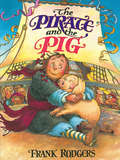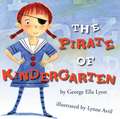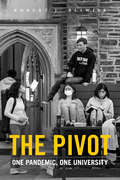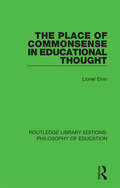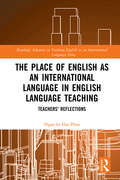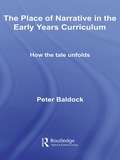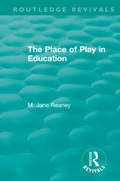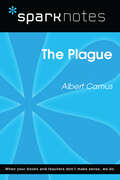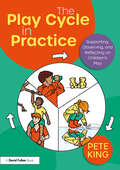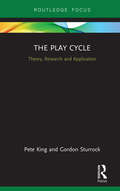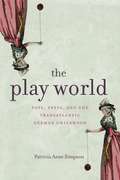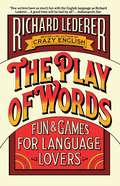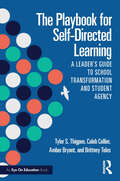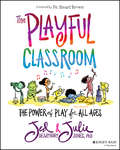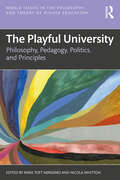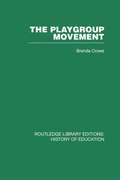- Table View
- List View
The Piper: The Epic Betrayal of Biblical Consequence
by Dennis BankThe founder of My Strong Tower Ministries unveils 24 Biblical truths that have been distorted in order to hide God&’s authentic purpose for you. Betrayal is a violation of trust that causes damage far beyond the event itself. The betrayed lose what is most important to them. The Piper—Satan—knows, better than most of us, which deviations he needs to fabricate to get us off the course to our eternal destiny. He corrupts the written Word with eloquence so that its readers can bring a curse upon themselves simply by reading or hearing it. The Piper knew how to twist what God said to entice Adam and Eve into rebellion—thus dooming them and future generations to captivity and destruction. Likewise, we have only one commandment that we must get right—but the Piper has perpetrated an epic betrayal, unwittingly promoted through our own teachers various Bible translations. Indeed the shepherds fiddle while the people are perishing. Cult experts have warned of serious doctrinal errors and changes that abound in the holy books of factions like the Jehovah Witnesses. Now see for yourself how the same apocryphal beliefs that abound in the fictitious works of cults also abound in the very modern Bible translations mainstream Christianity recklessly trusts.
The Pirate and the Pig
by Frank RodgersStop that soppy snivelling!" yelled Billy Blackheart. "It's time for a dip!" Captain Peg-Leg Doubloon and Matey the pig are best friends. And best friends stick together - especially when the black-hearted crew of the Jolly Rotter decide to mutiny. A delightful and heart-warming tale of friendship and bravery.
The Pirate of Kindergarten
by George Ella LyonGinny was not born a pirate.<P><P> But since her birth she was headed in that direction. This book tells the story of Ginny's voyage toward earning herself an eye patch--a voyage made mostly at school.<P> No other kid there had the honor.<P> Words and pictures offer up a double helping of surprise on the subject of seeing.<P> Winner of the Schneider Family Book Award
The Pirates' Three Wishes: Independent Reading Green 5 (Reading Champion #517)
by Katie WoolleyThis story is part of Reading Champion, a series carefully linked to book bands to encourage independent reading skills, developed with Dr Sue Bodman and Glen Franklin of UCL Institute of Education (IOE) Fantastic, original stories are accompanied by engaging artwork and a reading activity. Each book has been carefully graded so that it can be matched to a child's reading ability, encouraging reading for pleasure. Perfect for 5-7 year olds.In this twist on the traditional tale The Three Wishes, two pirates receive three wishes from a fairy, but they do not use them wisely.
The Pistachio Prescription
by Paula DanzigerA gorgeous new package for Paula Danziger’s backlist with an introduction from Ann Martin! Cassie Stephens is dealing with a lot: She’s got asthma. She’s running for freshperson class president. World War III is being waged daily in her home, beginning at the breakfast table and ending with slammed doors at night. Her older, shorter, more beautiful sister never ceases to remind Cassie that she is a giraffe. Cassie’s not really sure how it started, but eating pistachio nuts always makes her feel better. No matter how weird it sounds, those little red nuts are just the prescription for Cassie’s troubles. Paula Danziger’s novels are hilarious, genuine, and full of dynamic female characters that have won the hearts of her readers and turned her books into beloved classics. These playful covers full of charming details capture the spirit of Paula’s stories and will brighten up the bookshelves of her fans and a new generation of readers.
The Pivot: One Pandemic, One University
by Robert J. BliwiseThe COVID-19 pandemic presented higher education with an unprecedented challenge: How could institutions continue the basic work of teaching and research while maintaining safe environments for their faculty, staff, and students? In The Pivot, Robert J. Bliwise traces Duke University’s response to the pandemic to show how higher education broadly met that challenge head-on. Bliwise interviews people across the campus: from bus drivers and vaccine researchers to student activists, dining hall managers, and professors in areas from English to ecology. He explores the shift to teaching online and the reshaping of research programs; how surveillance testing and reconfiguring residence halls and dining sites helped limit the virus spread on campus; the efforts to promote student well-being and to sustain extracurricular programs; and what the surge in COVID-19 cases meant for the university health system. Bliwise also shows how broad cultural conversations surrounding the 2020 presidential election, climate change, free speech on campus, and systemic racism unfolded in this changed campus environment. Although the pandemic put remarkable pressures on the campus community, Bliwise demonstrates that it ultimately reaffirmed the importance of the campus experience in all its richness and complexity.
The Place of Commonsense in Educational Thought (Routledge Library Editions: Philosophy Of Education Ser. #8)
by Lionel ElvinThroughout the course of his career Lionel Elvin has worked closely with experts in many different areas of the educational field and has found that in coming to conclusions about either theory or practical policy, commonsense is indispensable. The author explores the idea of commonsense in education in this study, first published in 1977, and e
The Place of English as an International Language in English Language Teaching: Teachers' Reflections (Routledge Advances in Teaching English as an International Language Series #3)
by Ngan Le PhanThis book aims to contribute to the discipline of teaching English as an international language by exploring teachers’ reflections on the recent changes within the English language for their teaching profession. It presents a comprehensive and thorough examination of the place of English as an international language in English language teaching, especially in an Asia-Pacific context, looking at Vietnam and countries in which the context of ELT is similar. It examines and revisits the relevance of teaching implications, teaching of cultures and teaching materials currently employed in an EFL context. The author investigates a range of critical issues in teaching English in today’s EFL context as well as challenges in implementing new teaching ideas to meet learners’ demands to communicate with speakers from various backgrounds. Finally, the book presents a number of research-informed implications for pedagogy, theory and research in teaching EIL in ELT.
The Place of Humanities in Our Universities
by Mrinal MiriThis volume examines the critical role of the humanities in universities in India and attempts to redefine its place, meaning and function in education. Bringing together distinguished scholars in the country, it debates the status and predicament of the humanities in the academic programmes within universities. The issues raised here touch upon the entire gamut of problems that a university faces in finding an adequate, rightful and wholesome place for the humanities in its academic curriculum. It discusses the difficulties in the specific identity of disciplines classed under the humanities, the powerful reach of the sciences and technological inroads in the teaching and practice of all disciplines, the relative academic balancing of disciplines in different universities in India, the culture, value and the idea of the university, digitisation of the humanities and online access and their specific impact on research in the concerned disciplines. The volume also presents an instructive debate on the so-called appropriation of traditional social science concerns by other departments. This book will interest those in education, humanities and social sciences, governance and public policy, and South Asian studies.
The Place of Narrative in the Early Years Curriculum: How the Tale Unfolds
by Peter BaldockNarrative in the Early Years Curriculum offers a timely new perspective on the place of narrative in the early years curriculum. Applying the results of up-to-date psychological research to day-to-day practice in pre-schools, day nurseries, schools and out of school play care settings, the author help readers to understand just what it is that makes so many story books produced for pre-school children in recent years a success and what deeper purposes they serve. Offering helpful advice on what works, the book shows how good practice based on practical experience is underpinned and clarified by research findings. Furthermore, it illustrates that an understanding of the development of narrative competence can challenge current ideas on various areas of early years practice, including child protection, health and safety and the consultation of children.
The Place of Play in Education (Routledge Revivals)
by M. Jane ReaneyOriginally published in 1927, this was a book written specially for teachers and parents, based upon the writer’s practical experience and research. It deals with the fundamental importance of play in the child’s development and as a basis for all education. A set of 74 games, arranged by Miss Amy Whateley, is appended, in four groups according to the four play periods of childhood. Today it can be read and enjoyed in its historical context.
The Places of Van Morrison’s Songwriting: Venturing in the Slipstream (Routledge Studies in Popular Music)
by Geoff MunnsWhat can we learn about Van Morrison’s life and work as a songwriter through his songs? This book looks closely at the lyrics and music from a selection of his songs. Some are very well-known - ‘Brown Eyed Girl’, ‘Cleaning Windows’ and ‘The Healing Game’. Others are less familiar. Through these songs the book offers insights into some of the most important ideas that the songwriter has explored across his five-decade plus career, starting from the Them period and extending through his solo albums. These readings show how thinking about Morrison’s use of place provides a specific lens that contributes to a greater understanding of his art. The songs are organized into chapters that reflect many of the important places in Morrison’s work as he ventured professionally and imaginatively away from the places of his upbringing towards a wider musical world. These places are in city streetscapes and country landscapes – in home places of streets and ditches, in the enclosed spaces of rooms, in the expansive reaches of the natural world, in indeterminate and specific foreign lands. A picture emerges of the journey that Van Morrison details through his songs, one that sees him first wandering as a boy through his East Belfast haunts, and then venturing out to a wider world away from this local place.
The Plague (SparkNotes Literature Guide Series)
by SparkNotesThe Plague (SparkNotes Literature Guide) by Albert Camus Making the reading experience fun! Created by Harvard students for students everywhere, SparkNotes is a new breed of study guide: smarter, better, faster. Geared to what today's students need to know, SparkNotes provides: *Chapter-by-chapter analysis *Explanations of key themes, motifs, and symbols *A review quiz and essay topicsLively and accessible, these guides are perfect for late-night studying and writing papers
The Plaid Avenger's World: A Populist Apocalypse Edition
by John Boyer"In the Plaid Avenger's world, we will strip off the shallow window dressing in which you have been trained to see the world donned, we will lay it bare to see what is really happening around the planet. We do this in order to gain enough insight about the current state of the world to truly understand the how and why and where things are happening right now. In this world, no single government or press dictates our views; no single political party shapes our opinion; no single religion or ethnicity tints our not-so-rose-colored glasses. We will see the world in plaid: a mystical weaving of facts, figures, cultures and viewpoints from every corner of the planet, culminating into the fabric that is today."--Page [2].
The Planning and Management of Distance Education (Routledge Revivals)
by Greville RumbleOriginally published in 1986, The Planning and Management of Distance Education examines the problems faced by those who are setting up and managing distance education systems of various kinds. The book begins by considering definitions of distance education and various models which can be used to describe and understand distance education systems. The second chapter considers various general education models and relates these to distance education. The concepts introduced in the first two chapters form a background to the rest of the book. The next section looks at the aspirations of those setting up distance education systems, the economics and costs of such systems, and the process of planning a distance education system from scratch (chapters 3-5). Chapters 6-11 consider aspects of planning and management – organisation, staffing, planning, budgeting, the management of the academic processes related to materials development and the provision of local student services, production management (the management of materials production and distribution), operations management (the management of the delivery of student services) – and the impact of new technology on production and operations management, and finally, evaluation. The short concluding chapter draws together some of the themes running through the book.
The Play Cycle in Practice: Supporting, Observing, and Reflecting on Children’s Play
by Pete KingThis book explores how the Play Cycle can help practitioners to observe and understand children’s play and support their interactions with children. It explains the six elements of the Play Cycle – pre cue, play cue, play return, play frame, flow, and annihilation – and shows how practitioners can use this to guide their interventions.Building on the author’s research and including an updated and revised theory of the Play Cycle, the book applies the Play Cycle to key aspects of provision alongside examples from a wide range of settings. Chapters cover: The indoor and outdoor environment and resources Child-led and non-directive play including risk The adult role, play maintenance and interventions The Play Cycle and Play Cycle Observation Method The Play Cycle in Policy and Practice Including vignettes and reflective questions, this text brings the theory and application of the Play Cycle fully up-to-date and is essential reading for practitioners and those studying play-related courses, for example, playwork, childcare, and early years education.
The Play Cycle: Theory, Research and Application (Advances in Playwork Research)
by Pete King Gordon SturrockTwenty years after Gordon Sturrock and the late Professor Perry Else’s 'Colorado Paper' introduced the Play Cycle, this theory of play now supports professional playwork practice, training and education. The Play Cycle: Theory, Research and Application is the first book of its kind to explain the theoretical concept of the Play Cycle, supported by recent research, and how it can be used as an observational method for anyone who works with children in a play context. The book investigates the understandings of the Play Cycle within the playwork field over the last 20 years, and its future application. It addresses each aspect of the Play Cycle (metalude, play cue, play return, play frame, loop and flow and annihilation) and combines the theoretical aspect of the Play Cycle with empirical research evidence. The book also provides an observational tool for people to observe and record play cycles. This book will appeal to playworkers, teachers, play therapists and professionals working in other contexts with children, such as hospitals and prisons. It will support practitioners and students in learning about play and provide lecturers and trainers with a new innovative teaching and training aide.
The Play World: Toys, Texts, and the Transatlantic German Childhood (Max Kade Research Institute)
by Patricia Anne SimpsonThe Play World chronicles the history and evolution of the concept of play as a universal part of childhood. Examining texts and toys coming out of Europe between 1631 and 1914, Patricia Anne Simpson argues that German material, literary, and pedagogical cultures were central to the construction of the modern ideas and realities of play and childhood in the transatlantic world.With attention to the details of toy manufacturing and marketing, Simpson considers prescriptive texts about how children should play, treat their possessions, and experience adventure in the scientific exploration of distant geographies. She illuminates the role of toys—among them a mechanical guillotine, yo-yos, hybridized dolls, and circus figures—as agents of history. Using an interdisciplinary approach that draws from postcolonial, childhood, and migration studies, she makes the case that these texts and toys transfer the world of play into a space in which model childhoods are imagined and enacted as German. With chapters on the Protestant play ethic, enlightened parenting, Goethe as an advocate of play, colonial fantasies, children’s almanacs, ethnographic play, and an empire of toys, Simpson’s argument follows a compelling path toward understanding the reproduction of religious, gendered, ethnic, racial, national, and imperial identities, emanating from German-speaking Europe, that collectively construct a global imaginary.This foundational and deeply original study connects German-speaking communities across the Atlantic as they collectively engender the epistemology of the play world. It will be of particular interest to German studies scholars whose research crosses the Atlantic.
The Play World: Toys, Texts, and the Transatlantic German Childhood (Max Kade Research Institute: Germans Beyond Europe)
by Patricia Anne SimpsonThe Play World chronicles the history and evolution of the concept of play as a universal part of childhood. Examining texts and toys coming out of Europe between 1631 and 1914, Patricia Anne Simpson argues that German material, literary, and pedagogical cultures were central to the construction of the modern ideas and realities of play and childhood in the transatlantic world.With attention to the details of toy manufacturing and marketing, Simpson considers prescriptive texts about how children should play, treat their possessions, and experience adventure in the scientific exploration of distant geographies. She illuminates the role of toys—among them a mechanical guillotine, yo-yos, hybridized dolls, and circus figures—as agents of history. Using an interdisciplinary approach that draws from postcolonial, childhood, and migration studies, she makes the case that these texts and toys transfer the world of play into a space in which model childhoods are imagined and enacted as German. With chapters on the Protestant play ethic, enlightened parenting, Goethe as an advocate of play, colonial fantasies, children’s almanacs, ethnographic play, and an empire of toys, Simpson’s argument follows a compelling path toward understanding the reproduction of religious, gendered, ethnic, racial, national, and imperial identities, emanating from German-speaking Europe, that collectively construct a global imaginary.This foundational and deeply original study connects German-speaking communities across the Atlantic as they collectively engender the epistemology of the play world. It will be of particular interest to German studies scholars whose research crosses the Atlantic.
The Play of Words
by LedererDo you know the connection between the expression A HARROWING EXPERIENCE and agriculture, between BY AND LARGE and sailing, between GET YOUR GOAT and horses, or between STEAL YOUR THUNDER and show business? You probably have heard the comparisons HAPPY AS A CLAM, SMART AS A WHIP, PLEASED AS PUNCH, DEAD AS A DOORNAIL - but have you ever wondered why a clam should be happy, a whip smart, punch pleased, and a doornail dead? By playing the fifty games in this book , you'll discover the answers to these questions as well as hundreds of other semantic delights that repose in our marvelous English language.
The Play's the Thing: Teachers' Roles in Children's Play (Early Childhood Education Series) (Second Edition)
by Gretchen Reynolds Elizabeth JonesResponding to current debates on the place of play in schools, the authors have extensively revised their groundbreaking book. They explain how and why play is a critical part of children's development, as well as the central role adults have to promote it. This classic textbook and popular practitioner resource offers systematic descriptions and analyses of the different roles a teacher adopts to support play, including those of stage manager, mediator, player, scribe, assessor, communicator, and planner. This new edition has been expanded to include significant developments in the broadening landscape of early learning and care, such as assessment, diversity and culture, intentional teaching, inquiry, and the construction of knowledge. New for the Second Edition are: additional theories on the relationship of teachers and children's play: current issues from media content, consumer culture, and environmental concerns; recent brain development research; how to use digital technology to make children's play visible; and more.
The Playbook for Self-Directed Learning: A Leader’s Guide to School Transformation and Student Agency
by Caleb Collier Tyler S. Thigpen Amber Bryant Brittney TolesThe Playbook for Self-Directed Learning offers school leaders a student-centered, relationship-driven approach to fostering learner-led success and autonomy at school. In self-directed learning, learners set their own goals, manage their own progress, and assess their own outcomes, all under the guidance of teachers and administrators. This accessible book offers evidence-based insights, real-world examples, and practical techniques for leaders seeking to transform their schools and empower students to become responsible for their own learning within an interdependent network of relationships with educators, peers, and involved adults. Each chapter includes a variety of strategies for supporting the conditions in which students can enthusiastically develop self-regulation, time management, adaptability, problem-solving, and other important skills. Principals, superintendents, teacher-leaders, and curriculum/assessment designers will come away with bold, yet intuitive methods for transforming schools into self-directed learning environments.
The Playful Classroom: The Power of Play for All Ages
by Jed Dearybury Julie P. JonesShows teachers how and why they should bring play into the classroom to make learning meaningful, relevant, and fun. Research studies show that all students—young and old, rich and poor, urban and rural—benefit immensely from classrooms filled with art, creativity, and laughter. Fun, playfulness, creative thinking, and individual expression reinforce positive experiences, which in turn lead to more engaged students, better classroom environments, and successful learning outcomes. Designed for K-12 educators, The Playful Classroom describes how teachers can develop a playful mindset for giving students meaningful, relevant and fun learning experiences. This unique real-world guide provides you with everything you need to incorporate engaging, hands-on lessons and creative activities, regardless of the level and subject you teach. Building on contemporary and seminal works on learning theory and play pedagogy, the authors explain how to inspire your students by bringing play. into your classroom. This clear, user-friendly guide supplies practical strategies and effective solutions for adding the missing ingredients to your classroom culture. Access to the authors’ companion website provides videos, learning experiences, and downloadable teaching and learning resources. Packed with relatable humor, proven methods, and valuable insights, this book enables you to: Provide meaningful experiences that will benefit students both in school and later in life Combine the principles of PLAY with traditional curricula to encourage creative learning Promote trust, collaboration, and growth in students Develop a playful mindset for bringing the arts into every lesson Foster critical thinking in any school community The Playful Classroom: The Power of Play for All Ages is a must-have resource for K-12 educators, higher education professionals, and readers looking for education-based professional development and training resources.
The Playful University: Philosophy, Pedagogy, Politics and Principles (World Issues in the Philosophy and Theory of Higher Education)
by Nicola Whitton Rikke Toft NørgårdThis book provides philosophical, political and practical insights that open ways for the university in going beyond its tightly controlled state and into more playful and imaginative futures.In the context of a marketised and regulated environment that stifles creativity and curiosity in higher education, this collection provides an antidote that lies in the potential of play. It identifies tactics and tools for playful practices to conjure real utopias and pathways for the present and possible futures. Pulling together global perspectives from a wide array of different disciplines including higher education, sociology, philosophy, media studies, design, literature, play studies, game studies and political science, it concludes with a collaborative chapter that offers philosophically and theoretically grounded principles for the playful university. The book shows that it is possible to reimagine a higher education in which students and staff approach their studies with a sense of purpose, care, and openness to explore, imagine and build a better future.Looking beyond pedagogy to imagination, and wonder as important perspectives within the university, this is an essential read for those interested in play and subversion in higher education.
The Playgroup Movement
by Brenda CroweOriginally published in 1973, this reprints the fourth, updated edition of 1983. This book defines playgroups, examines their needs and problems and traces the growth of the association to meet the demands of a lively and demanding movement.

